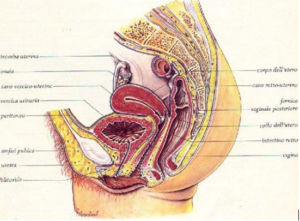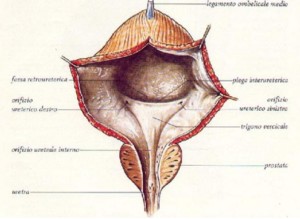ANATOMIA E FISIOLOGIA DELLA VESCICA

The female bladder and urethra (FIG. 1) are located in the pelvis, bordered posteriorly and inferiorly by the rectal ampulla, posteriorly and superiorly by the uterus, anteriorly by the pubic symphysis, and anteriorly and inferiorly by the vagina.
The peritoneum, a sac encasing the abdominal organs, covers only the upper wall (the so-called bladder dome) of the bladder.
The bladder walls consist of three layers: the inner mucosal layer (urothelium), the middle muscle-vascular layer (detrusor muscle), and the outer serosal layer (pericystium).
Macroscopically, on the internal bladder wall (FIG. 2), in the anteroinferior

portion, there is a triangular region called the trigone. This area contains the two ureteral orifices laterally (where urine enters from the kidneys) and the internal urethral orifice medially (where urine exits).
Physiology of Bladder Innervation
(From the European Association of Urology Guidelines)
Bladder and pelvic organ innervation integrates urogenital functions with social life. The bladder and sexual organ nerves originate in the frontal lobe and terminate in the pelvic plexuses. A physiological state requires continuous interaction between the parasympathetic, sympathetic, and somatic systems.
• Parasympathetic fibers: These promote detrusor contraction and relaxation of the bladder neck and urethra. They originate in the sacral segments S2-S4.
• Sympathetic fibers: These inhibit parasympathetic activity, originating from thoracolumbar segments D10-L2 and extending to the hypogastric plexus.
• Somatic fibers: These provide motor input to the voluntary pelvic floor muscles and part of the urethra, originating from the S2-S4 segments.
Bladder innervation includes afferent fibers (transmitting signals from the bladder to the brain) and efferent fibers (carrying signals from the brain to the bladder).
"Female cystitis is a frequent condition, affecting at least 35% of women at least once in their lives, with a higher incidence than men due to the anatomical conformation. Causes can include bacteria such as Escherichia coli, which are often transmitted directly or during sexual intercourse. Effective management requires precise diagnosis, such as urine culture with susceptibility, and targeted therapy, avoiding inappropriate treatments. Prevention, through correct lifestyles and good hydration, is essential to reduce recurrences and complications."
"PhD Federico Guercini - Urologist - Andrologist"

